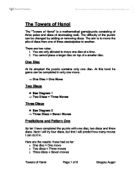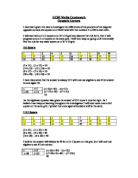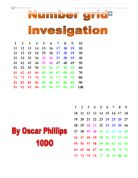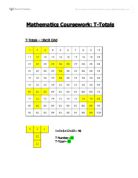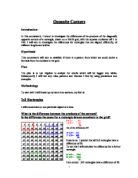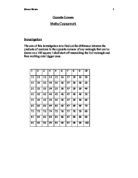Investigation into T-shapes.
Investigation into T-shapes Looking at the 9-9 grid below and the T-shape drawn on it, The total number of the numbers on the inside of the T-shape is called the T-total 2 3 4 5 6 7 8 9 0 11 12 13 14 15 16 17 18 9 20 21 22 23 24 25 26 27 28 29 30 31 32 33 34 35 36 37 38 39 40 41 42 43 44 45 46 47 48 49 50 51 52 53 54 55 56 57 58 59 60 61 62 63 64 65 66 67 68 69 70 71 72 73 74 75 76 77 78 79 80 81 82 83 84 85 86 87 88 89 90 The t-total for this T-shape is: +2+3+11+20=37 so 37 = T-total The number at the bottom is the T-number, so the T-number for this shape is 20 Aims: ) Investigate the relationship between the T-total and the T-number 2) Use the grids of different sizes. Translate the T-shape to different positions. Investigate relationships between the T-total and the T-number and the grid size. 3) Use grids of different sizes again, try other transformations and combinations of transformations. Investigate relationships between the T-total and the T-number and the grid size and the transformations. Aim 1- the solution 2 3 4 5 6 7 8 9 0 11 12 13 14 15 16 17 18 9 20 21 22 23 24 25 26 27 28 29 30 31 32 33 34 35 36 37 38 39 40 41 42 43 44 45 46 47 48 49 50 51 52 53 54 55 56 57 58 59 60 61 62 63 64 65 66 67 68 69 70 71 72 73 74 75 76 77 78 79 80 81 82 83 84 85 86 87 88 89 90 T69= 50+51+52+60+69 =282 T22=3+4+5+13+22 =47 in the diagram below it
Personal Exercise Program
GCSE PE COURSEWORK Task: Plan a training programme for a specific activity. I have decided that I am going to use football as the activity that my training programme is going to be based on. I will perform my circuit in the gym. My general health is very good. I do not suffer from asthma or any other breathing problems and I have no allergies. I eat quite healthily getting lots of carbohydrates especially as well as proteins, starch, vitamins and all the required fats. Firstly I am going to show how much exercise I would do in a typical week. * 3 hours of in school games lessons * Half an hour of football training for school * 45 minutes of cricket training for school * 1 hour of football training for Bishops Lydeard YFC * 1 hour and 20 minutes matches on Sundays Bishops Lydeard YFC. * 1 hour cricket training for Fitzhead CC * 3-4 hours of football at lunch break for leisure As you can see I am already a very active person which helps me towards being a very fit person. Stamina is my main strength which is why I normally compete in long distance events on sports days and I am good at the bleep test. It is for all these reasons that I will be trying to push myself to my limit. The two areas of specific fitness I will be working on to make my performance levels in football higher are AGILITY and UPPER BODY STRENGTH. Agility is a major component of football. Being
The Towers of Hanoi
The Towers of Hanoi The "Towers of Hanoi" is a mathematical game/puzzle consisting of three poles and discs of decreasing radii. The difficulty of the puzzle can be changed by adding or removing discs. The aim is to move the pile of discs from one of three stacks/poles to another. There are two rules: . You are only allowed to move one disc at a time. 2. You cannot place a larger disc on top of a smaller disc. One Disc At its simplest the puzzle contains only one disc. At this level he game can be completed in only one move. ==> One Disc = One Move Two Discs * See Diagram 1 ==> Two Discs = Three Moves Three Discs * See Diagram 2 ==> Three Discs = Seven Moves Predictions and Pattern One So far I have completed the puzzle with one disc; two discs and three discs. Next I will try four discs, but first I will predict how many moves I can do it in. Here are the results I have had so far: o One disc = One move o Two discs = Three moves o Three discs = Seven moves The first thing I notice is that for each extra disc you can find the number of moves by doubling the number needed for the previous disc and the adding one. ==> ( 1 x 2 ) + 1 = 3 ==> ( 3 x 2 ) + 1 = 7 So for four discs I predict I will take 15 moves as that would be the next result in the pattern. ==> ( 7 x 2 ) + 1 = 15 Four Discs * See Diagram 3 ==> Four Discs = Fifteen Moves Predictions and




